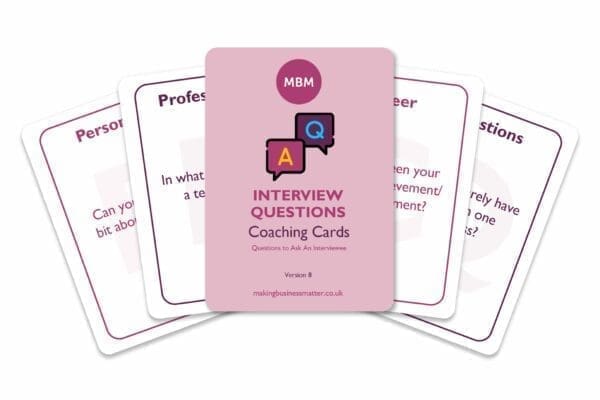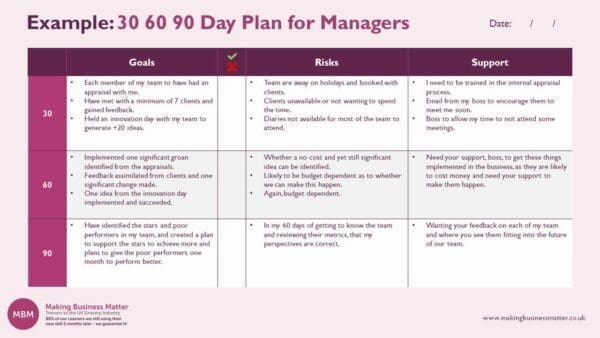Navigating Success with a Plan
Perhaps you are starting a new job with a new company. Perhaps you have received an internal promotion to a leadership position, or you find yourself in this new role by another means. In either case, you need a robust action plan to orient yourself in the right direction and kickstart your journey. A great tool that is available is the 30-60-90 day plan that we will be discussing here.
We will be covering the following aspects of this type of plan.
- What is the 30-60-90 day plan
- When can we use this tool
- Benefits of the 30-60-90 day plan
- Elements that make the tool more successful
- Create a 30-60-90 day plan in 7 steps
- A good example of the plan in use
What is the 30-60-90 Day Plan?
This tool sets a roadmap for the next 90 days of what needs to be achieved. A good 30-60 90-day plan is a completed template that describes your goals, risks, and support needed for the next 3 months.
The document lists the following:
- Your priorities (Goals),
- What might trip you up (Risks),
- What you need from your business to achieve the goals (Support).
In essence, this is your approach for the next 90 days of a new job, new role, being a new manager, or for a project. We will look at these elements more in this article.
How Did this Tool Come About?
This tool is believed to be a version of the 100-day plan. The 100-day plan seems to be more popular with USA Presidents, though the roots are believed to have been derived from the French ‘Cent Jours‘ – 100 days. This refers to the period of 1815 between Napoleon Bonaparte’s return to Paris from exile on the island of Elba and his final defeat at the Battle of Waterloo, after which King Louis XVIII regained the French throne.
Franklin D. Roosevelt made the first 100-day plan popular when he took office in 1933. He took swift action to calm the nation’s crippling financial panic, and where he then began rolling out the programs that made up his New Deal, including 15 major pieces of legislation in the first 100 days.
Nowadays, companies around the world use the 30-60-90 day plan in a similar way.

>> Interview Questions Coaching Cards <<
Possible Uses of This Type of Resource
There are a number of applications for a 30-60-90 template. It doesn’t always have to be when joining a new company.
For example, you can use this resource when you:
- Take part in an interview: Create a 30-60-90 day plan when asked in the interview what you would prioritise in your first 3 months.
- Join a new company: lead your team to success within the first 3 months by creating a 30-60 90-day plan to set the tone and pace.
- Obtain an Internal promotion: Make a good impression in your newly promoted role by using the tool and showing your contribution.
- Want to re-ignite your team: Use this tool to re-energise your team to focus on key goals and targets.
For any of these reasons, the 30-60 90-day plan template is a useful tool. However, you might wonder how to use it effectively. We have a sample template to share, which is available later in this article.
Sticky Learning ® is 7 times more effective than 1-day training courses. Plus, you will get a Chain of Evidence proving your Return on Investment. Discover soft skills training that changes behaviours long term.

Benefits of Using the 30-60-90 Day Plan
I have personally used this template over my years in leadership roles. I can confirm that there are many benefits to using this effective resource. Some of them include:
#1: Create Focus
As most people know when you start a new job or take on a new role it can be overwhelming. By having your approach written, you focus more on what is important.
Use this type of tool to create clear goals and targets for the team. This way, you provide your team with a roadmap to follow. A 30-60 90-day plan is like the North Star, keeping you focused on what is important and the direction of travel.
Also, create an understanding of where the team will focus their time and efforts to achieve success.
#2: Measure Success
Without this tool, you might look back at the last 3 months and wonder what you have achieved. However, when we use this tool, we see exactly what has been achieved over the time frame.
Set the plan with clear time frames. Then, check back regularly on your progress. Also, realign the direction where needed to stay on track. Have ways to measure the success of your goals, such as an increase in revenue, a decrease in complaints, etc. Measures are a great way to energise the team towards achieving great things.
#3: Prioritise More Effectively
We have lots to get done. But, how do you know where to start? This tool helps you plan more effectively what needs to be tackled first.
First, look at all of the tasks and goals you may need to address. Next, understand what is realistic to achieve in terms of the 90 days available. Now, show your efficiency by adding these prioritised tasks to your plan.
#4: Increase Productivity
A great benefit of the 30-60-90-day plan is the boost to productivity within the team. Research shows that teams with clear goals and objectives are more productive due to clarity and direction. These tools motivate the team to collaborate and get things done in short periods of time. The goals themselves energise the team towards the end target.
Therefore, use this resource to energise your team. Also, drive motivation in the team by challenging the team to achieve success together through their combined efforts.
#5: Effective Communication
Imagine joining a new team for the first time. Now, you need to achieve results with the help of the team. However, how is that possible when you don’t really know your team members yet? Work together on these plans to understand one another. Communicate openly with the team about contributions and expectations. Also, include the team in the process. All of these help you communicate more effectively throughout the entire journey.
All of these benefits, and more, show that the 30-60-90 day plan should readily be used by leaders for short-term goals.

Elements of the 30-60-90 Day Plan
Before we work on the actual plan, we need to understand some of the key aspects of an effective plan. To have an effective plan, there are certain elements that any of these plans should include.
We need to:
- Consider the company mission, vision and core values.
- Know the current market share and financial state of the company.
- Align your priorities with those of the company.
- Make sure your action steps are concrete and realistic.
- Know how you will measure each goal.
- Keep in mind future goals after 90 days to maintain the momentum.
When these elements are considered you will achieve better success.
Create a 30-60-90 Day Plan in 7 Steps
Now, let’s look at how to create one of these plans in 7 easy steps. We will take all of the previous understandings of the resource and see how they combine to get the best results.
The template below is available just by clicking on the image:

Then There are 7 Steps:
#1: Know your Key Areas of Responsibility
We know why we were hired. However, do we really know the expectations of our role? We probably ask ourselves: ‘Why are you on the payroll?’. A simple question, but not always easy to answer. Before you do anything, find out what you are paid to do. Yes, many things, but what does the business expect you to achieve at a higher level?
Look at doing the following:
- Understand your job description.
- Ask questions of your leaders about their expectations.
- Speak with your team about the overall dynamic and what to include in the plan.
- Take advice from peers who have been in their positions for a while. They have been there, done that.
- Use your experience to understand what may be best to prioritise.
- Look at customer and financial records for guidelines.
#2: Set SMART Goals
To have a good action plan, we need SMART goals to work towards. This can be easier said than done. The first thing you need to ask is: What are we here to accomplish? This is the key question that must be answered.
There are a number of ways for us to understand what our goals should be.
- Brainstorm with your team.
- Conduct a SWOT analysis or use a TOWS matrix.
- Review company reports for areas of concern or improvement.
- Look at customer feedback for trends in negative aspects of the operation.
- Review the availability of resources to achieve results.
Once you have your key ideas of what you want to achieve, these then need writing as SMART targets.
You need SMART targets because you want to look back and know that you have achieved those targets. An ambiguous target is easy to write. However, proper job satisfaction cannot be achieved if there are no ways to measure success.
So, do you remember what SMART stands for? Actually, we have used it in some of our other articles. See below for a great example of the different elements of SMART to create effective goals.
Click the image below for a higher resolution.

#3: Identify Potential Risks
So, the first part of our 30-60 90-day plan template has been completed. Once you have your SMART targets in column 1, then each target needs to have the biggest risk put against it. Here, we look at the following.
- Identify the biggest reason that the goal/target will not be achieved.
- Look at internal and external factors.
- Analyse previous company performance and hurdles.
- Listen to customer feedback about your product or service.
All of these sources of information can help you identify the potential risks. This is important to plan ahead for and be prepared for. Remember, do not skip this step. Otherwise, your plan could easily fail.
#4: Know Your Support Needs
Once you have finished assessing the risks in column 2, proceed to outline the support required to achieve each target/goal in column 3. Write down what is necessary for those goals to materialize and for the reduction or elimination of those risks.
We have a number of areas to at. So:
- Consider your manning.
- Analyse your financial needs.
- Think about the different equipment you will use.
- Identify IT requirements.
- Know the level of support you can expect from leaders and peers in other areas.
- Connect with 3rd party suppliers and partners.
There are reasons to keep all of these in mind. Don’t overlook any support elements that can help you and the team be successful. Instead, give this part of the plan the same time and consideration as the other 2 steps.
#5: Review the Draft with Your Leader
Share this completed template with your boss to get their feedback. Do it quickly because the clock is ticking and you only have 90 days. Do this to ensure your plan is aligned with your leader’s expectations and company objectives.
Avoid jumping right into action before taking this step. I am speaking from experience. Previously, I used this tool when starting a new job. Without checking, I launched my 30-60-90-day plan with my team. We wasted 3 weeks of our time heading in the wrong direction. So, learn from my experience. Check and double-check before you launch your plan. It will save time and effort in the long run.
#6: Launch the Plan with your Team
So, you had your meeting. Now, update the plan based on your boss’ feedback. Then, share the updated copy with them. Also, book your first 30-60 90-day plan review in their diary for 2 weeks time because you’ll want to check in with your line manager and share your progress. Plus, this will focus your mind.
Now, share the elements of the plan that you want the team to see in order to get them focused on achieving your goals as well. Include them in the process to ensure buy-in. Also, create enthusiasm for success every step of the way to keep people motivated.
#7: Set Time for Check-Up Sessions
Finally, book yourself a meeting to take a look at your 30-60 90-day plan every Friday afternoon. Don’t give more than 15 minutes. In these sessions, write one thing that you will do next week to keep the plan alive and on track. Analyse where the team are currently. See where any gaps exist. Plan how you will overcome these barriers to stay within your timeframes. Also, acknowledge any further barriers you should be ready for. Prepare in advance to save time later. Believe me, it pays to plan ahead.
A Good 30-60-90 Day Plan Example
As promised we have an example to share with you. Here, you will see a completed template below for a manager. The example is for a new manager who has taken over the team and is keen to make a difference early on in their new job. The priorities that the new manager has chosen is about understanding their team, and their clients, and delivering new idea.
Click the image below for a higher resolution.

When the new manager looks back at the last 90 days they can be proud to have achieved:
- An appraisal with each of their team and delivered one significant change that will make the team happier.
- Met and gained clients from 7 clients and delivered one significant change that will make the clients happier.
- Held an innovation day and delivered one significant change.
- Mapped their team in terms of performing and not performing, with support plans in place.
Now, the new manager can show they can:
- Improve team morale and engagement.
- Understand the needs of their clients.
- Exceed expectations in short periods of time.
- Set clear and effective goals that are achievable.
Conclusion
In essence, a 30-60 90-day plan is about making choices that deliver focus and ultimately results. However, one cannot accomplish this without scrutinizing all aspects of the plan in detail. Remember to follow the 7 steps we shared while keeping the elements and benefits of the plan in mind.
Updated: September 2023 by Ailish O’Rourke-Henriette




